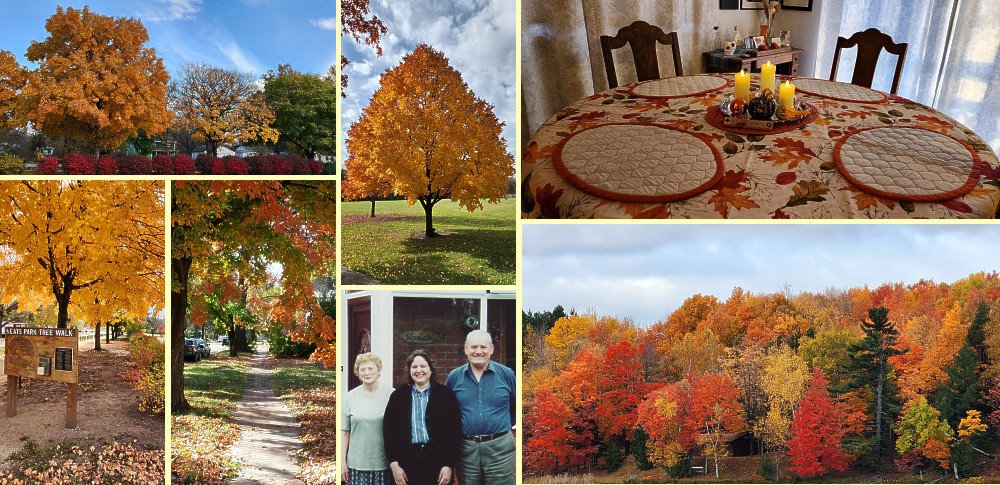Kansas Snapshots by Gloria Freeland - November 14, 2025
"Every leaf speaks bliss to me ..."
People who know me are well aware of the fact that I love the leaves of autumn. Husband Art said he still laughs when he remembers a walk
we took shortly after we started dating. I'd seen leaves someone had raked into the street and couldn't resist running through the pile.
I do love the swishing sound they make walking through them when they collect on sidewalks. Each year, I rescue some for table centerpieces
and photograph others from various angles.
I did all of these last Saturday.
I enjoy it when Art sings "Autumn Leaves" at this time of year:
The falling leaves drift by the window
The autumn leaves of red and gold ...
"Every leaf speaks bliss to me, fluttering from the autumn tree." Those words from an Emily BrontŽ quote on a kitchen towel a
friend gave me also resonate.
Although the beauty and poetry of autumn grab my heart, the science behind the changing hues intrigues me as well. I had
heard that the various colored compounds are already in the leaves, but are normally masked by the predominant green of the
chlorophyll that uses sunlight to produce food for the tree. But I recently discovered it's not that simple.
Art heard a piece on National Public Radio that delved into this color mystery. Knowing my interest in the subject, he sent me the
link to, "Why do only some leaves turn red in the fall?" It seems that scientists don't agree on an answer.
Every autumn, trees work to recover the nitrogen in their leaves before they fall. It's a necessary element in the chlorophyll,
which uses sunlight for building proteins and DNA. The loss of chlorophyll exposes yellow-colored chemicals that have been in
the leaves all along. But the red colors come from new compounds the tree manufactures.
Nicole Hughes, a biologist at High Point University in North Carolina, has made a career out of studying this phenomenon. In the
interview for the NPR piece, she said, "The red was not there beforehand."
The nitrogen-recovery process can be disrupted by an excess of sunlight now present due to the loss of chlorophyll. One
hypothesis is that the red pigments serve as a sort of sunscreen for the plant.
Also interviewed was biology professor Susanne Renner of Washington University in St. Louis. She said many physiologists concur with
the photo-protection idea proposed by Hughes. She noted that Europe gets less solar irradiation than the northeastern United States,
and has fewer red trees, which supports this idea.
Renner's example made me think of a particular visit to our Welsh friends Tom and Freda Parrish in North Wales. They were eager to
describe their bus tour of the Northeastern United States from the previous fall. They had visited Boston, New York City, Washington,
D.C., and Philadelphia. Yet I was startled by their response to my asking what stood out. Immediately, both answered it was the
beautiful brightly-colored trees of upstate New York!
However, not all researchers agree with Rennerís and Hugh's assessment of the source of the red color. Penn State University evolutionary
biologist Marco Archetti was quoted in the NPR article too. He said a relatively small number of trees have red leaves. "I think it's
about 15 percent, more or less, if you look at all the trees in the world," he said. If the red was for protection against excess light,
"why don't more species need photoprotection?"
He thinks it's more likely this trait evolved with insects. Archetti has done research showing that aphids avoid trees with red
leaves, preferring instead to lay eggs on those with green or yellow leaves. This notion is supported by the fact that red colors
are found to a greater degree in wild apple trees, which have to deal with more insects than domesticated ones that are sprayed.
Another hypothesis, this one proposed by Simcha Lev-Yadun of the University of Haifa in Israel, is that the red color might have
anti-fungal properties.
Currently, Hughes is studying tree species that are more flexible in terms of colors - trees of a single species that turn yellow,
orange, or red. She's been feeding different oak species varying amounts of nitrogen to see if it affects their color. She's also
studying trees that simultaneously have some purple, some yellow, and some green leaves.
While I am curious about the cause, there is also a part of me that is somehow pleased that we don't have all the answers. These
oranges, bronzes, yellows and reds that brighten our fall days touch me a bit more deeply, knowing there is still something of a mystery
involved.
